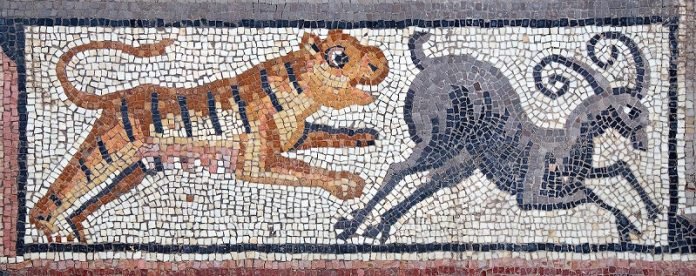
A team of researchers led by University of North Carolina’s Professor Jodi Magness, and Dennis Mizzi from the University of Malta, recently made an incredible discovery at an ancient synagogue in Huqoq, Israel.
Huqoq was an old Jewish village from around 400 C.E., a long time ago during the late Roman period.
The team uncovered a stunning mosaic, which is a kind of artwork made from small pieces of colored stone, glass or tiles.
This beautiful mosaic was found at the main entrance of the synagogue. It is made up of a large picture that has a mysterious Hebrew writing in the middle, circled by a wreath.
The sides of the wreath show lions resting their paws on bull’s heads. The whole artwork is framed with a border of predator animals chasing other animals.
Next to the wreath, there are more words written in another language called Aramaic. These words are the names of the people who either gave money to make this artwork or the artists who created it.
These names were written down so people will remember them and their good deeds.
The team also found more parts of a different mosaic that they had discovered earlier in 2012 and 2013. This one tells stories from the Bible about a strong man named Samson. There are pictures showing Samson with foxes and carrying a heavy gate. They also found images of a soldier from an enemy group called the Philistines.
Another mosaic discovered in 2022 shows a famous biblical story from Judges chapter 4. It has pictures of a prophetess named Deborah sitting under a palm tree, and a woman named Jael, who killed a bad general named Sisera. These are the earliest pictures ever found of these important women from the Bible.
Other amazing finds from the Huqoq site include mosaics that show other Bible stories, like Noah’s Ark and the parting of the Red Sea.
There’s also a picture that might show a meeting between Alexander the Great and a Jewish high priest. This would be the first time a story that’s not from the Bible was found in an ancient synagogue.
The researchers also found out that the synagogue got a big makeover in the 14th century. A new major road was built nearby, and a popular tourist spot called the Tomb of Habakkuk was set up.
People from all over came to visit, and the synagogue was expanded to welcome them.
Last but not least, the team found a huge courtyard with stone paving and a row of columns. Later on, a giant structure was built on top of it, but no one knows what it was used for.
Follow us on Twitter for more articles about this topic.
Source: University of North Carolina at Chapel Hill.



